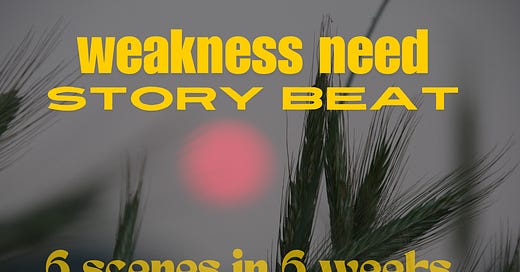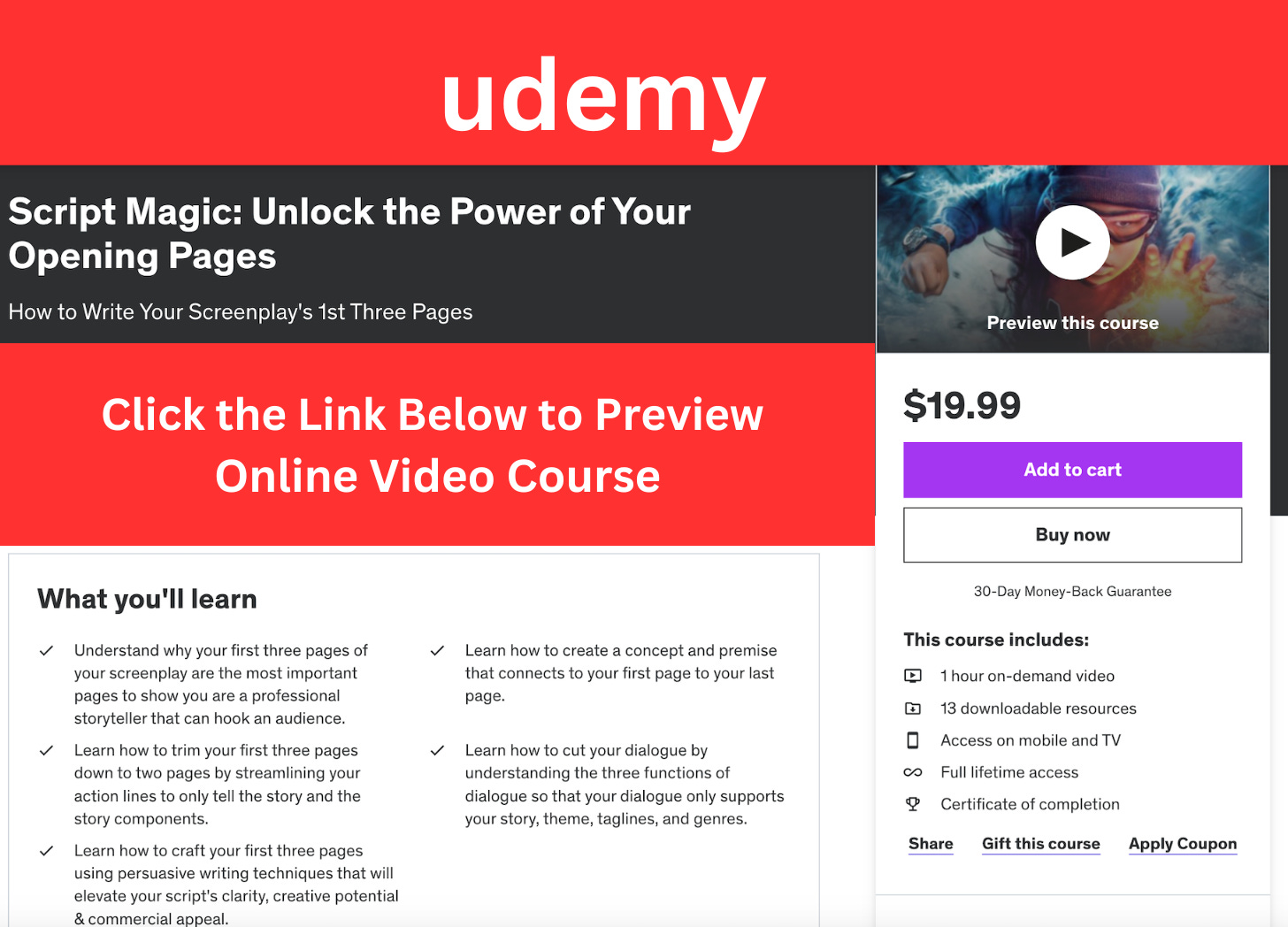The Weakness/Need Story Beat sets your hero on a journey of learning. Then, the character undergoes change built within the character’s ghost. The change is shown through their world. Along the way, you affect the plot, desire line, and inner/outer transformation from the character’s “Weakness” and “Need.”
Scenes Recap
Scene 1: The Ghost Story Beat sets up the weakness/need.
Scene 2: The Story World Beat plays out the weakness/need.
Scene 3: The Weakness/Need Story Beat defines your character’s outer goal, inner moral struggle, and overall arc and change because of what they learn.
The Weakness/Need Story Beat is the most important beat, and it’s twofold.
CHARACTER WEAKNESS DEFINED
On one hand, WEAKNESS is symbolized by a physical loss, whether an object, a person, a status, or a situation, which must be regained or realized to make the past right again. It’s your main character’s outer and visual goal.
CHARACTER NEED EXPLAINED
On the other hand, the NEED is the psychological trauma that is suffered and results in an emotional, moral bend from this loss. A skewed internal belief emerges due to the loss or ghost, creating the desire to fulfill the weakness. It’s your main character’s inner goal and dark psychological motivation.
COMBINE WEAKNESS AND NEED
Your task is to combine WEAKNESS and NEED in this story beat and throughout your plot, as the NEED comprises the idea or inner belief that fuels the outer narrative drive to fulfill the character’s WEAKNESS or GOAL.
Again, the NEED is the psychological and moral misalignment that fuels the heroine's inner and outer journey to achieve their desire line.
It’s important to point out that the psychological NEED is the belief that will change in Act Three. This is called the new revelation. The new revelation will provide fresh opportunities, allies, and ideas to finally fulfill the WEAKNESS, securing the object, person, status, or situation of their initial desire.
For example:
TOP GUN (1986)
WEAKNESS (physical goal): Will he graduate to be a top gun?
NEED (psychological moral dilemma): What holds him back?
FLASH DANCE (1983)
WEAKNESS (physical goal): Will she get into ballet school?
NEED (psychological, moral dilemma): What holds her back?
HOW TO USE THE WEAKNESS/NEED STORY BEAT
Understand how to use the Weakness/Need Story Beat to define your main character's desire line because it is the gas of your narrative drive.
One way to understand the Weakness/Need Story Beat is to purposely enmesh it in character development by referring to your GHOST STORY BEAT.
Using the Ghost Story Beat, define the two key elements for your character:
their WEAKNESS, which is a goal that is tied to what they want to fix or redeem from their past,
and their NEED, which reflects how they view themselves because of that past experience and shows the audience how they will change.
Then, plot the character arc with the Weakness/Need Story Beat in mind, and you will show a clear change in the main character for your audience.
The more your main character changes, the more interesting the character is.
However, the downfall of plotting the character arc is that you only have a limited number of pages to do this.
To plot the character arc effectively using the weakness/need story beat, start at the end with the character's new revelation.
How to Create a Character's New Revelation
Ask the following:
What happens on the last page?
What is the character's new belief that heals the psychological moral dilemma with light?
And where will the character end, meaning—what object, person, or thing will they have recovered?
Writing Tip: Write the Last Page First and work backward to define an effective two-pronged weakness/need approach to plot your character’s arc.
Start by defining your main character's new self-revelation and the new belief that will help them reach their goal.
Then, pick the opposite belief to understand and clearly define your character's initial weakness/need at the beginning of the story.
Character change comes from the Weakness/Need Story Beat.
Character change is only made possible at the story's beginning, and everything else that happens in the story is based on this concept.
Story Rule: The less the character changes, the less interesting. The more change—the more interesting.
But it’s riskier because you must sort through a myriad of scenes that can show change, and then you must select the most profound scenes while still adding in your Secret Sauce.
So, what parts will you change about the character?
Going from an administrative assistant to a company president is not wholly a character change. THE DEVIL WEARS PRADA (2006) comes to mind.
So, what are good examples of character change defined by your main character's weakness/need stemming from a ghost story, loss, or drive to make the past right?
The Weakness/Need Story Defines Character Change
Character change involves changing and challenging basic beliefs, leading to new moral actions that are opposite the initial weakness/need and mainly focusing on the inner struggle and psychological and moral NEED.
The more your main character changes, the more interesting the character is.
Here is a list of possible character changes that show how the weakness/need starts the desire line of your story and your main character's journey.
Q: How do characters change in these story frames?
Animal to Human, King Kong (2005)
Child to Adult, Good Will Hunting (1997)
Adult to Leader, The Woman King (2022)
Leader to Tyrant, Oppenheimer (2023)
Leader to Visionary, Black Panther: Wakanda Forever (2022)
A: The answer is clear. Clarity of change is necessary for audience satisfaction, and the changes stem from the original weakness/need.
Use the WEAKNESS/NEED to DEFINE the SINGLE STORYLINE or DESIRE
The Weakness/Need Story Beat also helps you define a single desire line that fulfills the weakness by retrieving an object, a person, a thing, or a situation.
A single desire equals a spine that is easy for the audience to follow. Be specific with a Single Desire because the audience needs to know what's happening.
Let’s repeat the example from the beginning of the article. How much more do you understand the Weakness/Need Story Beat?
TOP GUN (1986)
WEAKNESS (physical goal): Will he graduate to be a top gun?
NEED (psychological moral dilemma): What holds him back?
FLASH DANCE (1983)
WEAKNESS (physical goal): Will she get into ballet school?
NEED (psychological, moral dilemma): What holds her back?
Film Examples of the Weakness/Need Story Beat
1. External Conflict - WEAKNESS: Overcoming the Shadow of the Past: WHIPLASH (2014)
The character's WEAKNESS, as in WHIPLASH, is their desire to reclaim something stolen from them (or from someone they love), often connected to a talent or love they once had. Their ghost story is a powerful external reminder—perhaps a tragic accident or a betrayal—that caused them to lose what they loved most, leaving them with an unresolved need to fix the past. However, the world and the people around them keep reminding them that what they once had is gone, and every attempt to regain it results in further failure. The character's flaw lies in their obsessive need to prove that they can recover what was lost, unable to see that true growth will come only when they stop clinging to the past and accept who they are without it.
Example: WHIPLASH (2014)
Andrew Neiman (Miles Teller) is a young jazz drummer whose obsession with becoming the greatest musician is fueled by a desire to prove his worth, particularly after a childhood where he felt plagued by the failed writing career of his father. Because of his father's failure, Andrew hungers day and night to become one of the greats. His ghost story is tied to his deep insecurity and fear of failure to repeat the steps of his father's unrealized dreams. Doing whatever it takes at all costs to be a top drummer, even enduring abuse, is Andrew's weakness/need. Under the brutal mentorship of Terence Fletcher (J.K. Simmons), Andrew pushes himself beyond all limits to reclaim the success and validation he believes he deserves. His obsession with regaining what he perceives as lost potential comes at the cost of his health, relationships, and mental well-being, showing that true growth only comes when he learns to balance ambition with self-acceptance.
2. Internal Conflict - NEED: Seeking Redemption for a Lost Passion: A STAR IS BORN
The character's NEED, as in A STAR IS BOARN, stems from a guilt over a past event they couldn't control. This event, their ghost story, haunts them daily, reminding them of a failure that robbed them of something they once loved and cherished. This loss shattered their confidence and created an overwhelming need to make things right. Their arc involves rediscovering that passion and healing the wound of that loss, but first, they must confront the internalized shame and self-blame that prevents them from moving forward. Their flaw is avoidance, as they constantly try to fill the void left by what was taken, believing redemption lies in external success rather than in facing their guilt head-on.
Example: A STAR IS BORN (2018)
Jackson Maine (Bradley Cooper) is a once-successful musician haunted by his past failed family ties and the loss of his fame, which he tries to mask through substance abuse. His internal conflict revolves around his inability to make peace with his fading career. He ignores he's losing his sense of hearing, a passion and God-given talent that defined his entire life. He seeks the redemption of fame by helping Ally (Lady Gaga) rise to stardom. Still, he's unable to fully confront his own self-destructive behaviors, ultimately leading to his tragic downfall. Blindsiding himself to love and numbing all of his senses with addiction to hold onto his illusion of success and fame is Jackson's weakness/need.
Why subscribe?
Story Waves is a reader-supported publication. To receive new posts and support my work, consider becoming a free or paid subscriber.
Udemy: Click to Preview the Online Video Course.
Subscribe to Story Waves!
Access screenwriting and storytelling lessons.
Get the discounted $79 ANNUAL subscription or $8/month to receive:
Growing Archive of all Story Wave posts, writing workshops, teaching videos, downloadable class notes, and templates
Join Story Waves Writing Challenges
Story Waves Community of writing support and paid posts
Get the discounted $159 FULL ACCESS subscription to receive:
Access to STORY GROUP and work with me every first Sunday of the month, 2-3:30 pm EST, where I demo page rewrites live from volunteers and teach from my Story Waves lessons.
Receive a $100 discount on all Story Consultations.
p.s. Replays will be available for workshops. Watch them at your convenience.
✨ Invest in yourself and your Story! Commit to one year with my guidance and get the discounted annual subscription. You, your writing, and your career are worth it.
Thank you for supporting Story Waves! Consider becoming a paid subscriber and get the benefits of Story Group and Story Consultation discounts. See FULL ACCESS.
Subscribed
I look forward to reading your stories and connecting in 2024!
Best wishes,
Kelly E. Keough







